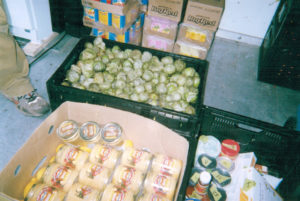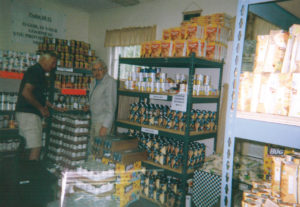SNAP for YOU
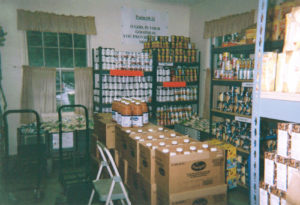
Think back to the time when you were a child. Life was probably less complicated then. Occasionally your parents or grandparents or maybe a school teacher, or a rabbi, priest, or pastor had talks with you about life.
Your mother, father, grandmother, teacher may have spoken about sex, money, God, doing right from wrong, not stealing. These talks were important.
Well, now you are an adult with your own life. Consciously or unconsciously, these early life talks shaped you and still influence you to this day. The reality is that the person who took the time and effort to make you a successful adult may now be in need of a talk. It’s entirely possible that this older person of influence to you is quietly doing without the food necessary to lead a healthy life.
Why is this happening?
Well, there may simply be more days in the month than money. Many seniors in our country have outlived their pensions, savings, ability to hold down a job. Statistics tell us that one senior in seven doesn’t get enough to eat. SNAP is one successful way to help seniors.
Seniors are eligible for SNAP.
If you are a senior, please apply for these benefits. You worked all your life, paid your taxes, contributed to the economy. It’s time to benefit from all the contributions you made throughout your life.

SNAP helps pay for the food you need to live a healthy life. When you eat healthier food, you can prevent and control some chronic health issues. This will lower your medical bills.
When you get groceries with SNAP, you’ll have money for other things you need.
SNAP is a debit card offering privacy. That way, if you don’t want anyone to know you receive SNAP, they won’t.
When you use SNAP, your community benefits. This is because you bring money into your local economy which helps farmers, grocers, and local businesses.
When you receive SNAP, you are not taking money away from someone else who might need it more. There are enough SNAP dollars for everyone.
Apply for SNAP at your local Department of Social Services office.

Thank you for reading this article. Please refer this blog post to your preferred social media network.
Please share it with your friends or anyone who may benefit from its message.
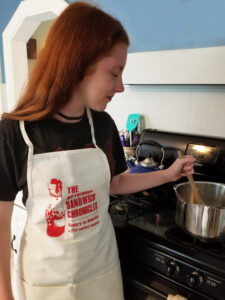
If the information in this article interested you, please check out more information in “Let’s Live with Thurman Greco”, a YOUTUBE channel with many interviews and much information about alleviating hunger in America.
The website, www.Thurmangreco.com lists books which give more information. You can also purchase T-shirts, aprons, and other items to support alleviating hunger in America.

No Fixed Address

“No Fixed Address” is dedicated to those in our country with no roof over their heads. See your neighbors, your friends, your relatives, in new ways as they describe their daily lives in their own words.
The people in this new book reveal themselves to be both brave and fearless as they go about their activities: work, laundry, children’s homework, appointments. Mostly they live like the rest of us. They just have no roof over their heads.
“No Fixed Address” is my newest book in the Unworthy Hungry series. It’s easy to read and understand. You won’t be bored, not even for a minute.
I hope you’ll order it today. Get an extra copy for a friend!
This book has an extra surprise. When you get a copy, you’ll be making a donation to a good cause. You’ll be fighting hunger and homelessness.
It doesn’t get much better than that!
Thank you for reading this article!
Please forward it to your preferred social media network.
Thurman Greco


What I Believe – Seniors in a Food Pantry
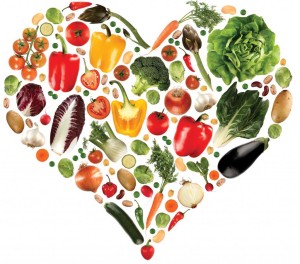
As seniors age, the courage we experience becomes more obvious as we feed hungry people. After all, what does a senior have to lose? Courage is a necessary part of the aging personality because our platform continually shrinks.
We’re often overlooked in the homeless arena. Those looking out forhomeless people focus on an older adolescent (especially if there’s an infant involved), and families. There’s just not much energy left over for hungry people seniors and cocker spaniels.
It never occurred to me that turning away hungry people in the pantry line was something I would do. Or could do. Or even consider doing. Turning away hungry people was not an option.
I came to the pantry as a crone or harridan depending on the circumstances and a person’s attitude toward me and my attitude toward hunger. I brought already formed opinions and beliefs, many of which were with me at birth.
Some argue that people are born as blank slates. I can’t agree. For one thing, I never experienced a blank slate when it came to hungry people. I didn’t have an “aha” moment when I met my first hungry person. I didn’t examine the value of feeding hungry people in a philosophy or government class. I never, at any time, analyzed the concept of feeding the hungry.
Because I lived my opinions about hunger, and because I got up close and personal with hungry people in Mexico and Venezuela, I was comfortable with the concept of feeding hungry people.
I never even considered not feeding hungry people I the food pantry. When I saw them, I remembered moments in Mexico and Venezuela and realized hunger is an intensely personal situation accompanying malnourishment. Hunger can lead to starvation.
Hungry people needing food are voiceless. Even though it’s harder on those with mental and emotional issues, it impacts everyone spiritually.
As they distribute pantry food, volunteers reduce costs in other areas of government: healthcare, housing, education.
A long-term poor diet contributes to illness which poor people can’t afford. Healthcare costs get shuffled over to taxpayers. When forced to choose between housing and food, the hungry often opt for housing. Later, if they can’t pay the housing costs and end up homeless. This results in further tax bills.
When school children are too hungry to learn, the damage is long term. They risk becoming uneducated adults unable to qualify for employment. Our problems flow to the next generation and the future.
DANA
“Hi, Dana. Come on in and shop. How’re you doing this week?”
“Fred’s still in the hospital. He’s been diagnosed with kidney disease and he’ll be on a special diet when he comes home.”
“I’m sorry to hear that.”
“I’m so glad you sent me to Dr. Longmore. He told me exactly who to go see, what paperwork to get, everything I needed to get care for him. I hope Fred’s coming home soon.”
“Dana, I’m so happy to hear this.”
“Thank God the pantry has all these fresh fruits and vegetables. By the way, do you have any laundry soap today?”
“I wish!”
I met Dana the first morning I worked in the pantry and she shared her adventures with me every week from that pantry day on. Of all the people going through the line in the pantry, I probably learned more about her than anyone else.
I never learned where she lived, how many children she had, where she came from or anything like that. What I learned from her was a running commentary of present tense food insecurity. She shared her daily struggle as she traveled through life trying to keep a roof over her head, clothes on her back, and food in her refrigerator.
Walking through the line weekly, she shared her life with me. I learned how she found a coat for the winter when the old one wore out and she had no money.
“Dana, your coat is beautiful!” It’s going to keep you so warm!”
“Yes, it is, isn’t it? You should have seen it when I found it. It was filthy!” I couldn’t even tell what color it was. I took it home, put it in the tub and worked on it all afternoon ’til I cleaned it up. Now look at it. It’s a perfect fit!”
I learned how she struggled to keep her car going…and then finally gave it up.
“The bus is working out real well over here. I catch it about two blocks from my apartment in Saugerties and ride it over. I wait in the hall ’til it comes back to take me home. I only have to carry my groceries about five blocks in all! I’m so lucky I found this bus. I get to ride free because I’m a senior!”
Dana was the most confirmed optimist shopper in the line. And, when Dana was in the line, I was the most confirmed optimist pantry volunteer in the place.

Thank you for reading this article! Please refer it to your preferred social media network.
Thurman Greco
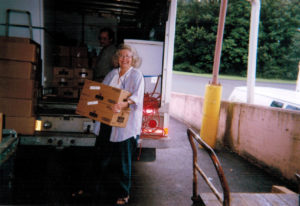

Reality in the Food Pantry
“How did we all fit?” What is the reality in the food pantry?
New shoppers always had funny looks on their faces the first time they shopped at the pantry. They expected to fill out forms. They expected to prove through documents they existed, had an address, and deserved the food.
They brought social security cards, utility bills, pay stubs, birth certificates. They came prepared to surrender their innermost private lives in exchange for recycled food originally rejected by a farmer, food manufacturer, grocer, wholesaler. It was all bound for a landfill.
The pantry didn’t have much in the way of screening procedures. For intake, shoppers signed their names and wrote the number of seniors, adults, and children in the household.
Nobody showed documents, especially not their social security cards. Our forms didn’t ask for addresses because the first inspector to visit the pantry after I became the coordinator assured me they weren’t necessary.
On pantry day, hungry people lined up and went through the pantry as fast as we could process them. In the two-to-three minutes they had in the room, they took their share of everything on the shelves, regardless of what it was. I never saw a person turn up a nose at canned peas, fresh spaghetti squash, or beets.
Pantry food is a shock to hungry people on their first visit. They see unrecognizable items. They sometimes sought a realitycheck. They don’t know what they’re called, how to prepare and eat them, how to store them. They have no idea what the nutritional content is.
Often, ethnic shoppers have no money and are separated from anything and everything they know or experienced. Undocumented citizens have no money, know few or no people, probably can’t speak the language, and they are forced by circumstances to shop in a pantry offering nothing familiar to eat. This must be a lonely feeling. They questioned the reality of their circumstance.
Worse, finding ethnic food, kosher food, Asian food, is simply not going to happen in a pantry. This is not necessarily by design. Food pantries only have food available to them that the food bank has to share. And, of course, the food bank shares what is donated.
At the end of the shift on pantry day, in the quiet of the closed pantry room, I counted totals. I carefully added the children, adults, seniors, and households in the pantry line that day. Often I was surprised at the end of a shift that such large numbers of hungry people shopped in the pantry in one afternoon.
The State of New York sent down clear guidelines, rules, conditions about what, how, and when pantries distributed food donated to hungry people.
Produce came from area farms. The Hepworth Farm, the Patroon Farm (owned by the Food Bank of Northeastern New York), and Migliorelli Farm as well as from other area farms throughout the Hudson River Valley, throughout the nation, and from foreign countries even. Farms grew and gave beautiful, fresh, clean, colorful, aromatic produce.
Produce made its way from a farm to a wholesaler, food manufacturer, and finally, a bakery or grocery chain in New York State. Food manufacturers, wholesalers, farmers, supermarkets salvaged food and donated it to the food bank. And that’s where the food banks came in. Food pantries received rejected food anywhere along the food chain. Volunteers put it on the shelves, and distributed it to hungry people lacking money to buy food.
Most fresh produce came directly to the food bank and what received was often organic but not labeled. It costs money to label produce as organic. The stickers alone cost money. Paying someone to apply them is another cost. The reason against labeling the produce is practical. Labeled or not, this beautiful food kept shoppers from feeling they were getting rations. That’s how the State of New York wanted it.
Not all Hudson Valley farms used organic methods. Migliorelli Farms, for example, didn’t label produce as organic because this family-owned farm used European agricultural standards to reduce health risks and exposure to pesticides by incorporating crop rotation, fertilization, irrigation, and planting systems.
Never ours, the food was in our safekeeping to give to hungry people, homeless people, the mentally ill, physically ill, poor, to anyone in need. Leastways, that was what I thought we were supposed to do with it.
New York State tax dollars worked in the pantry. When volunteers worked at the pantry, we did so willingly and for free.
Sometimes I thought I was the only one in town to see it this way. Many felt I fed the unworthy hungry, that I embraced the wrong people. None of the food boxes came to the pantry stamped Worthy Hungry Only. I never understood what unworthy hungry meant, who the unworthy were, where they came from. I didn’t understand unworthy hungry the same way I didn’t understand rocket science. I just didn’t get it. Because I didn’t get it, no one could sway my beliefs.
Instead, I understood hunger, giving, receiving, sharing, and abundance. When people signed their names and accepted food, miracles rippled out beyond the building, beyond walls and boundaries – to a divine experience.
While shoppers got food, they sought the resources to live meaningful lives and to trust there was something to believe in, cling to. They sought the focus to rebuild lives.
At the pantry day’s end, I was thankful people got groceries.
I searched and searched and got beyond hunger and abundance. My search was about the meaning of life. In my youth, (in my thirties), I asked two questions: What is the meaning of life? Whatever happened to the Anasazi?
In the pantry (in my seventies), I still searched for the meaning of life. My questions were different: How did I end up in a food pantry at my age? Who are the unworthy hungry. My questions were wrong. What I should have asked was “why”, now “how” or “who”.
All my life I felt when I got to be a woman of a certain age I would sit in the rocking chair I inherited from my grandmother and learn to knit or crochet. Maybe I would occasionally venture beyond home in my yellow Volkswagen convertible with a black top to paint a picture or two in a class nearby. I fantasize the top would be down at every outing to free my cotton top curls.
Instead, I worked in a small town food pantry in the midst of the biggest economic downturn for decades.
I managed a food pantry in a community where some weren’t interested in recognizing poverty and hunger existing under their very noses.
It came down to reality. I never found discovered the unworthy hungry because I never saw anyone in the pantry who didn’t need food. Those preoccupied with feeding with the unworthy hungry saw freeloaders who didn’t need the food, or didn’t belong in the line.
I saw grandmothers and mothers with children standing in the line without uttering a sound. Not in my wildest dreams did I figure out how they got the children to be so quiet and stand so still. Grandparents, aunts, uncles, siblings, and close friends stood in the line for as much as an hour on Wednesday or Thursday afternoon with children, mostly preschoolers.
Caregivers stood in the hallway weekly in cold, wet, dry, rain, snow, broiling heat inching their way down the long hall until their turn came in the pantry room. No one, either child or adult, complained about the freezing cold hallway in the winter where the only warmth came from the body heat of fellow shoppers. The nearest I ever got to a complaint was volunteers and shoppers wearing two hats in the winter. No one, neither adult nor child, complained about the oppressive summer hallway heat. The children never made a peep.
Many lived on fixed incomes unprepared for the financial costs and emotional roller coaster ride involved in raising someone else’s children. Ready or not, they cared for children when the biological parents couldn’t. For some, the situation was overwhelming. For others, it was just another day.
THREE SHOPPERS
I saw a cancer patient with finances reduced to a large box filled with bills and no money in the bank. He shopped weekly until his death.
I saw the woman whose brother had Alzheimer’s. She was his caregiver and he couldn’t be left alone. Sometimes she arrived at the pantry so disheveled it was difficult for her to stand in the line and shop. One afternoon she crashed her car into the bridge outside the pantry entrance.
I saw the widow with more month than money who refused to go to her children for help. She visited the pantry regularly. One shopping trip included the first anniversary of her husband’s death. She kept her pantry trips a secret from her children because she was embarrassed to let them know. This was a small community, so they eventually figured things out.
THE MOTHER AND GRANDMOTHER
She brings her young granddaughter to the pantry weekly. Sue is maybe four. She is shy. Dark brown ringlets frame her little cherubic face. Her expressions and posture tell me she’s still unaware of her situation. Her mother works two plus jobs. There’s not enough food to eat in this household. Her little dresses are threadbare.
This lovely child takes pleasure in the smallest gifts. Today, her treat is a can of juice a volunteer found in the storeroom that’s not dented. Her grandmother teaches her to stand in line quietly, smile, and say “thank you.”
When I see them, I see the universal mother and grandmother next door. I see a mother and grandmother working hard so that adorable little child has access to a good school, health care, safe streets.
They are our neighbors.
They are our family.
They are us.
I’m reminded we do not live in a we/they world.
Poverty hits children especially hard, with long-term consequences for behavior, learning, and mental health. They suffer the effects of going to bed hungry. Ketchup sandwiches and bowls of dry cereal don’t offer the nutritional strength a child needs to grow up into a healthy adult.
However this shakes out, the hungry are us.
Thank you for reading this post. Please refer it to your preferred social media network.
Thurman Greco

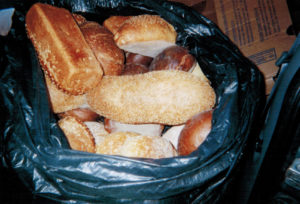

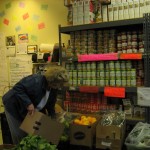
New Beginnings – Part 2 as I Explore the Spirituality of Hunger in America


Like many first-time pantry volunteers everywhere, I showed up that morning because someone from the church asked me to come. A slot needed to be filled and I stepped up to the plate when I was asked. I was a foot soldier in the army of the outreach. I tried to live up to my status in the church as a new member. I showed up at whatever activity needed help and did my share. Nothing more.
I had no desire to move up any ladder in the congregation.
On that morning of new beginnings, I had no premonition I would ever return to this pantry room.
I had no plans for this place in my future. I had a profession teaching reflexology, Reiki, and canine massage therapy in a healing space in my home on Tannery Brook.
This was a case of fools rushing. Knowing what I know now, I should have run out the door and never looked back. Mary could have handled the crowd that day without me. In the whole two hours, no more than a couple dozen people visited the pantry.
I wasn’t blessed with any psychic knowledge…certainly not the feeling of danger I felt when I saw the head of the building committee in the hallway outside the pantry months later.
There were no lines in the hallway at the new beginnings of my time there. People wandered into the pantry in groups of one and two to choose from cereal, soup, tuna, and peanut butter.
Never in my wildest thoughts on that day did I envision the pantry hallway filled with hungry people, the tiny room packed with fresh produce and jammed with shoppers.
By 2008, the tanked economy was well underway and waits in the hallway were an hour or more.
The Hunger Prevention Nutrition Assistance Program (HPNAP) passed down feeding guidelines which included whole-grain bread, 1% milk, fresh produce. By 2011, the building committee had rules dictating where people could stand, what bathroom they could use, and what parts of the hallway were off-bounds.
Never did I foresee monthly food deliveries averaging over 12,000 pounds.
Never did I imagine, on that day, building committee members angry over hungry people receiving food according to guidelines set down by the State of New York, the Department of Health, and the United States Department of Agriculture.
I never thought I would spend months grappling with the unworthy hungry, a concept introduced to me by a local religious leader. The concept wasn’t explained. Only the two words – unworthy hungry – were used in a sentence: “You are feeding the unworthy hungry.” This was something I never heard of before. What did she mean? Who were the unworthy hungry?
After that first morning in the food pantry, I drove home, pulled out a little notebook from a drawer and wrote what people said, like real writers do. When I wrote these things down, I felt my grandmother’s presence.
Her spirit was with me in the room. I looked around the dining area to see if someone had entered the room without my realizing it. But, no, I didn’t find a soul. I walked over to a cabinet and began my dialogue journal on that afternoon.
A shopper: “They cut my food stamps again. I don’t know how I’m going to make it. I have no money this month. My car died and I don’t know where I’m going to get money to fix it. If I can’t fix it, I can’t buy a new one either.”
Lillie Dale Cox Thurman spoke to me clearly that morning with emphatic, strong, direct instructions. She went straight to my head: “Write this down! Write this down too! Now…write this down.”
My grandmother, Lillie Dale Cox Thurman, stepped into my life on the first morning in the food pantry and never left. Not even when my mother, Uralee Thurman Lawrence, roared in with prayers and fast, furious, aggressive instructions which I resisted to the bitter end. Under their directions, I joined the crowd in the basement and was soon volunteering regularly.
So, now, I’ve got the second volume, “The Ketchup Sandwich Chronicles,” coming out on this blog.
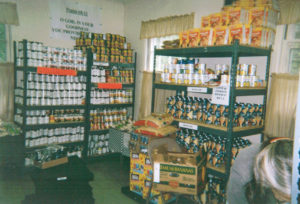
Thank you for reading this blogged book! Please refer it to your preferred social media network and stay tuned for future chapters!
Thurman Greco

My Story and the 9 Truths I Discovered
I began my life changing journey fighting hunger on a cool autumn Thursday in Woodstock, New York in 2005 where I volunteered for the first time at the local food pantry.
I was assigned a shift with Marie Duane. I drove over to the Woodstock Reformed Church, parked my car behind the buildling and cautiously walked in. I had never been to the pantry before.
I entered the empty hallway and found the pantry on the right. I walked into the room and there it was: a small space, actually, about 12′ by 16′. Each wall supported a set of metal shelving units. Each unit stood about 6′ high and 3′ deep with 4 shelves. Most of the shelves were empty. A few shelves had some food:
cereal
tuna
soup
peanut butter.
There was a little handwritten note in front of each display:
person: 1 item, family: 1 item.
There may have been other items on shelves but I don’t remember them.
A small table stood in the center of the room. A metal folding chair was placed in front of each window.
We sat in the chairs, Marie and I, and chatted as people trickled in. We discussed the usual: weather, gardening, knitting, decorating the alter at St. Gregory’s Episcopal Church.
“Hi. How are you? Will you please sign your name here?” Each shopper signed in and noted the number of adults, seniors, and children in the household. After signing in, the person walked around the room selecting from the cereal, peanut butter, tuna, and soup. The selected food was placed on the table and bagged to take home, wherever or whatever that was.
On this morning, not blessed with any psychic knowledge, I was totally unaware of experiences waiting for me in the pantry. Never in my wildest thoughts did I envision the hall filled with hungry people, the tiny room packed with fresh produce and jammed with shoppers.
Nor did I for 1 moment ponder the push back I would experience as the number of hungry seeking food grew. Within a few short years, this 2 dozen single homeless men – mostly Woodstock’s colorful characters – had swelled (due to a tanking economy) to over 300 people weekly. This number finally approached 500 people weekly before it was all over.
Now, in the autumn of 2015, our stock market experiences numerous “corrections”. I realize I learned some things over the years which, for me, are ground truths about the pantry.
Feeding the hungry with dignity is the most important thing.
Single homeless men are now far outnumbered by members of the Struggling Class, households of working people holding down 2 and 3 jobs just to pay the rent and buy the gas to get to work.
The 3 most hot button words in the English language are food, sex, and money. These 3 words are concerned with a person’s core beliefs, emotions, and spiritual attitudes. Food and money, or the lack thereof, loom large in pantries.
The sidewalks in our communities and cities have become wards of untreated mentally ill people. In our great nation we don’t hospitalize or otherwise treat many of our mentally ill. Instead, they they are incarcerated.
Some of these untreated mentally ill happen to be homeless. Homeless is not a category of people. It’s just a situation that happens. It can happen to anyone.
The 50+ senior population has many who lack enough $$$ for food and are largely a silent group. The bottom line is this: When our grandparents don’t get enough to eat, they often get sick.
I’m seeing a whole generation of children who have never been inside a grocery store.
Shoppers at our pantry can get a 3-day supply of food weekly. Their job is to make it last 7 days. Many share this food with a pet. Often, the only thing a person has left from a prosperous past is the dog.
The most difficult thing I see in the pantry is a Korean War vet getting food. Something I just can’t understand is how a person who served in a very brutal war, and subsequently spent an adult life working and paying taxes should have to be in a food pantry line in his old age.
Much of the food available to the hungry in food pantries is diverted from its trip to the landfill.
There is absolutely no excuse for anyone in our great nation to go hungry.
Thank you for reading this blog. The story is true. The people are real.
Please refer this article to your preferred social media network. Share this story with friends or relatives who might be interested.
Don’t forget to join the email list.
Thurman Greco
